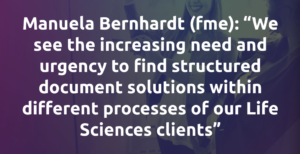
Structured content authoring is transforming drug approvals processes
Guest post by fme partner Maarten van Vulpen, Customer Success Manager, Fonto
In this dynamic, digital era – and in the context of expedited drug approvals processes, post pandemic – continued reliance on static, single-use Word documents to capture and publish or exchange critical information with Regulatory agencies makes no sense. It is hampering productivity, efficiency, compliance and visibility. Fortunately, there is a better way. Structured content authoring is already transforming drug approvals processes in Life Sciences.
In other industries, including the precision engineering and manufacturing-based automotive and aerospace industries, the automatic re-use of approved, structured content assets (fragments of approved text) is well established. Automatically generating onward documentation from a single source of approved content truth is the key to accuracy, reliability, and traceability as well as process efficiency.
And now Life Sciences, as it undergoes digital transformation, is beginning to recognize and reap equivalent benefits of structured content authoring (SCA) and automated content re-use, with a powerful impact on internal process efficiency.
There’s a practical imperative to this, too. In a bid to accelerate the approval of important drugs and make their own processes more efficient, health agencies are become more digital and dynamic in their information management and exchanges – an expectation they are passing on to drug manufacturers and license holders.
Yet, as long as these companies persist with Word/Excel/PDF based information and content management, they will only be creating more work for themselves in their efforts to keep up with those changing demands.
Driving new value from existing information with structured content
Pharma companies are already rich in regulated product information. The challenge is that much of this exists within single-purpose documents, dotted around different systems across the organization. This means that for each new purpose, teams have to go through protracted and laborious processes to locate, piece together, and seek approval for each new document use case – whether they’re generating a study report, submitting a new marketing authorization application, registering a product change, or updating labelling.
Structured content authoring tools like Fonto Editor strike right at the heart of this situation, transforming the way pharma subject matter experts (eg Clinical Trials, Regulatory, Quality or Safety teams) collate, publish, and manage vital drug information right across the product development, registration, and marketing lifecycle. Crucially, they are able to do this without having to brief out the content creation to technical writers, then check and approve their output. That’s because the SCA solution is intuitive for users, offering them a very familiar, Word-like experience, while building from content dynamic, reusable digital content assets.
Although there isn’t yet a single, agreed standard or schema for how documents should be constructed across Life Sciences globally, this will come in time and companies will be able to adapt to this relatively easily. That’s as long as they have got to grips with structured content authoring – and the immense scope for more reliable, efficient, and repeatable use of regulated information across a wide range of applications.
Transformation from the core
An obvious place to start in the adoption of SCA in pharma is the core data sheet, a key document representing the pharmaceutical company’s position on – and the definitive, correct, and current truth about – a product.
Once the core data sheet’s contents have been structured and stored as a series of digital content fragments, they can be flowed into a whole host of other documents including submission applications, reports, labels, and clinician/patient information, without risk of manual error – or the need for new rounds of internal content checks.
One of the top 5 pharma companies globally has already seen a 15% increase in productivity in processes linked to drug approvals, since adopting Fonto Editor to more automatically generate content that sails through internal checks.
By combining both Fonto and fme’s knowledge and experience with advanced ECM solutions, pharma professionals get several benefits. First, Fonto shields them from having to understand the ins and outs of XML formatting – a substantial win and time saver. Second, teams from across the drug lifecycle can gain seamless access to SCA capabilities from within their existing regulatory information management (RIM) platforms as a natural extension of their everyday work.
fme & Fonto: a formidable SCA partnership in Life Sciences
fme and Fonto share a strong pedigree in transforming Life Sciences content and data management, working together to integrate and embed SCA within companies’ Veeva, OpenText Documentum, or Generis CARA, or other systems. This means that relevant functional teams can shift to structured content management and authoring without having to learn to use new, separate tools.
For more details on structured content, Fonto has presented, and continues to present courses on the potential for structured content in Life Sciences via the Drug Information Association (DIA) – here’s a link to a recent session.
 As the Life Sciences industry grows more serious about digital process transformation, fme has been highlighting the potential of SCA, too. In this post from fme’s Manuela Bernhardt, she explain that “Data is the heart of the business, whereas documents are the ‘packaging’ to create context”.
As the Life Sciences industry grows more serious about digital process transformation, fme has been highlighting the potential of SCA, too. In this post from fme’s Manuela Bernhardt, she explain that “Data is the heart of the business, whereas documents are the ‘packaging’ to create context”.
A dynamic pharma future needs structure
Over time, the opportunities for transforming content management processes through re-use of approved digital assets with at least some degree of automation will only grow. The regulators, as well as competitive market pressures, will demand it; meanwhile technology vendors like Veeva will continue to pave the way for powerful content re-use, as long as this is planned properly (for instance, with the support of RIM vendors like Veeva delivered through specialist Life Sciences partners like fme and Fonto).
To find out more about the potential for structured content authoring and management in your own organization, download this data sheet covering fme and Fonto offerings.
Or contact us to start the discussion today!
About the author
Maarten van Vulpen is customer success manager at Fonto, the leading solution in structured content authoring. This role gives Maarten the opportunity to discuss structured content authoring, its advantages and innovation with customers and potential customers from multiple industries, including life sciences.
 fme AG
fme AG fme SRL
fme SRL
